Nourishing Newly Hatched Chicks: A Complete Guide
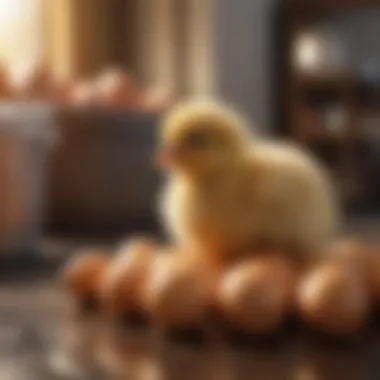
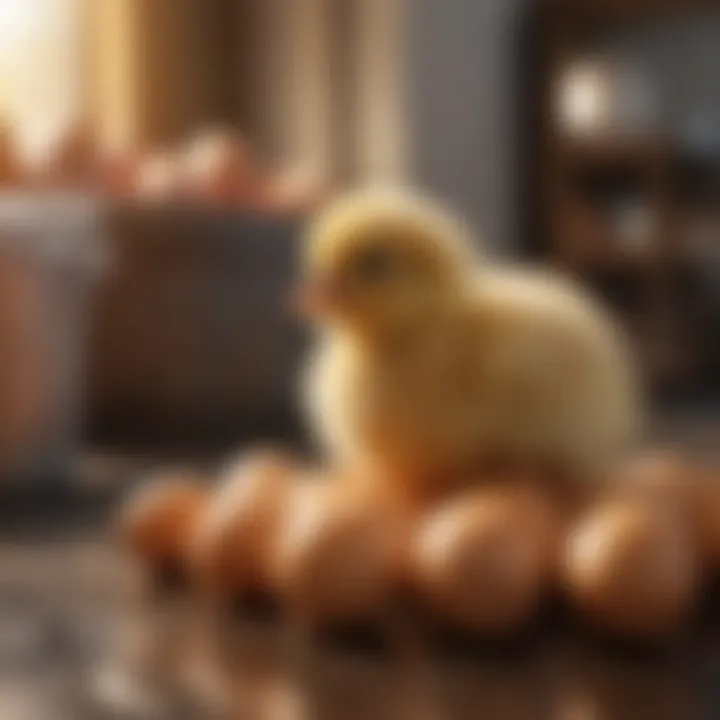
Intro
When it comes to raising newly hatched chicks, understanding their nutritional needs is akin to holding the keys to a thriving poultry enterprise. Much like how a seed requires special care to sprout into a robust plant, these little birds need the right nourishment to grow strong and vibrant. In this comprehensive guide, not only will we uncover the essential dietary components necessary for their growth, but also highlight specific feeding strategies tailored to various breeds. This insight is critical for ensuring that newly hatched chicks develop into healthy and productive members of your flock.
Understanding Your Pet
Pet Behavior Basics
Chicks, though delicate and small, exhibit a range of behaviors that are crucial to their development. Right from the start, they are curious creatures who explore their surroundings. When they’re first hatched, their instinct for pecking and scratching begins early. Being aware of these behaviors can help you create an environment conducive to their natural inclinations.
For instance, making sure there's enough space for them to explore and play is essential. Overcrowding can lead to stress and even aggression among baby chicks. To foster a harmonious atmosphere, allowing for some gentle exploration can aid their social skills as well.
Common Breed Characteristics
It’s worth noting that not all chicks are cut from the same cloth. Different breeds have unique characteristics that influence their care. For example, broiler chicks are bred for meat production and have faster growth rates. On the other hand, layer breeds like Leghorns are raised primarily for eggs, requiring different feeding regimens to support their specific growth and development.
Species-Specific Needs
Chickens have specific nutritional requirements that shift as they grow. For newly hatched chicks, a high-protein diet is crucial for muscle and feather development. Protein sources such as chick starter feed, scrambled eggs, and finely crushed insects provide essential nutrients. It is vital for poultry keepers to familiarize themselves with these species-specific needs early on.
Pet Care and Maintenance
Feeding Guidelines
Feeding newly hatched chicks isn't just about filling up a feeder. Timing and food types matter greatly. In their very first few days, they should have access to food almost round-the-clock to fulfill their energy needs. A good rule of thumb is to provide them with a starter feed rich in nutrients, especially protein, to promote rapid and healthy growth.
- Choose a starter feed with at least 20% protein.
- Make sure the feed is crumbled or finely ground to prevent choking.
- Provide fresh water daily, as hydration is as important as food.
Grooming Essentials
While grooming may not seem urgent in the early stages of a chick's life, maintaining cleanliness in their environment is essential. Regularly cleaning their living area can prevent diseases. Make sure to change bedding frequently and keep their water containers clean to avoid any contamination that can jeopardize their health.
Hygiene Practices
Maintaining a hygienic environment for chicks is crucial for their health. Keeping their living spaces dry and free of waste not only prevents disease but also keeps stress levels in check. Regularly check for any signs of wetness or droppings in the bedding. If you spot problems, act quickly to replace soiled bedding and keep things fresh.
"A clean space is a happy space for newly hatched chicks."
Training and Development
Basic Commands and Skills
It may seem preposterous to think about training chicks, but they can learn basic responses with gentle guidance. With consistent handling and positive reinforcement—like a treat for following you around—you can instill foundational behaviors that aid in their later development.
Behavioral Training Techniques
Establishing routines early on helps chicks feel secure. Use consistent verbal cues alongside visual signals to teach them where to find food and water. This kind of behavioral conditioning can reduce anxiety during feeding times.
Addressing Common Behavior Issues
As with all pets, newly hatched chicks may have their quirks. If they appear aggressive or overly restless, it’s important to evaluate their living conditions and potential overcrowding. Providing various perches and hiding spots can reduce conflict among chicks.
Health and Wellness
Routine Vet Check-ups
Even though your chicks are young, it’s wise to incorporate routine check-ups with a veterinarian experienced in poultry. They can catch any potential health concerns before they escalate. It’s also a golden opportunity to get advice tailored specifically to the breeds you are raising.
Vaccination Needs
Vaccinations can be particularly significant depending on your local health requirements and the environment where the chicks are raised. Discuss with your vet about what vaccines your chicks might need in their early months and plan accordingly.
Recognizing Signs of Illness
New poultry keepers need to be keen observers. Early signs of illness include lack of appetite, lethargy, or abnormal droppings. Understanding these cues can help you intervene sooner rather than later, safeguarding the health of your flock.
Enrichment and Activities
Indoor vs. Outdoor Activities
As your chicks grow, they may start to enjoy more expansive environments. While indoor activities help them develop key skills, outdoor exploration shouldn’t be overlooked. As long as they’re safe, letting them scamper in grassy areas can boost their well-being.
Interactive Toys and Games
There are myriad ways to engage chicks in play that can stimulate their little minds. Simple items like cardboard boxes or shallow dishes filled with sand can be great fun. This not only promotes enrichment but also discovery.
Socialization Opportunities
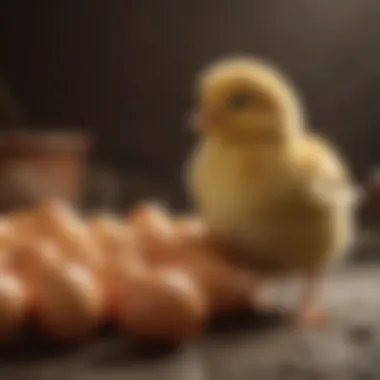
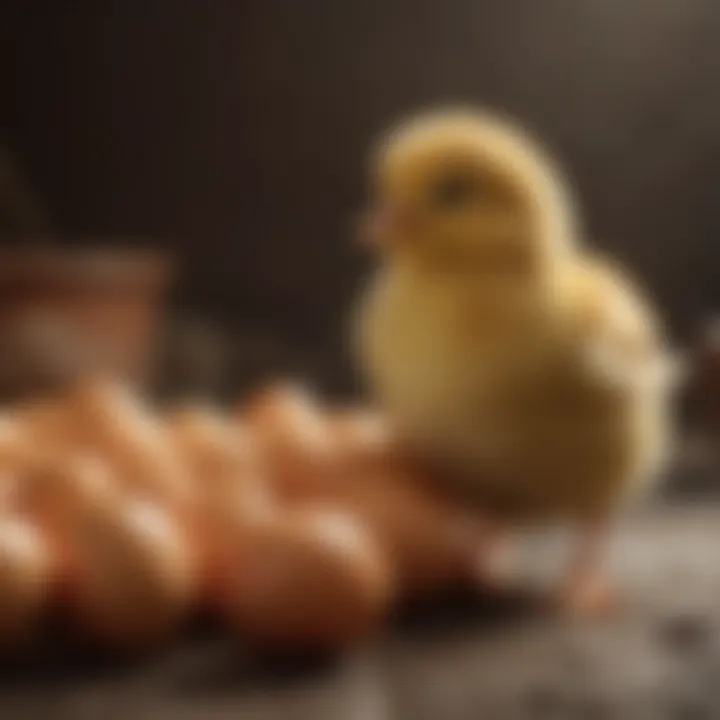
Encouraging interaction with humans as well as other birds can greatly enrich the lives of your chicks. By spending time with them and gently handling them, you promote healthy social behavior that can smooth their integration into a larger flock later on.
Preamble to Chick Nutrition
Understanding the significance of chick nutrition is foundational for ensuring the health and vigor of newly hatched chicks. Proper nutrition provides the essential building blocks for growth, organ development, and even behavior. When poultry keepers grasp the intricacies of chick feeding, they put their flock on a path to optimal health. In this section, we will delve into the importance of targeted nutrition, the physiological needs of chicks at this formative stage, and how these elements intertwine to shape their future well-being.
The Importance of Proper Nutrition
A chick's early days are crucial, as they depend entirely on the nutrients they receive to grow and thrive. The right nutrition can spell the difference between a healthy flock and one that suffers from deficiencies or illness. For instance, the rapid growth rate of chicks requires an abundance of proteins and essential vitamins.
Chick nutrition not only affects physical growth but also regulates their immune system, ensuring they are better equipped to fend off infections. It is essential to note that although a chick may appear lively, hidden nutritional deficiencies can lead to long-term health issues. Feeding them appropriate starter feeds, rich in the necessary nutrients, allows them to grow strong and develop fully.
"A bird's growth is only as strong as the feed it consumes; the earlier you get it right, the healthier they’ll soar."
Physiological Needs of Newborn Chicks
Newly hatched chicks emerge into the world with specific physiological needs that must be met promptly. Their small bodies require high-energy food to support their metabolism, which is peaking in those initial days. Factors such as temperature regulation also play a big role. Chicks cannot regulate their body temperature immediately after hatching, hence the requirement for a heat source alongside the right nutrition.
Supporting their development is not merely about food; hydration is pivotal too. Chicks need fresh and clean water available at all times to stimulate their digestive systems and enable nutrient absorption. Here are a few notable physiological needs:
- Energy: Essential for maintaining their high metabolism.
- Protein: Crucial for growth, muscle development, and immune functionality.
- Vitamins and Minerals: These micronutrients are absolutely vital to prevent deficiencies that hinder overall health.
By understanding these physiological needs, poultry keepers can better anticipate and cater to the specific nutritional requirements of their chicks as they start their journey into adulthood.
Initial Feeding Considerations
Feeding newly hatched chicks can feel a bit like walking on eggshells—quite literally. It’s a delicate dance that dictates the health and growth of your little ones. This section is vital because the initial food choices, along with the timing and their readiness to feed, can set the stage for strong development and vitality.
Timing of First Feed
Timing is everything, especially when it comes to the first meal of a chick's life. The moment a chick hatches, it's like pressing the play button on their journey towards health. Generally, chicks should be offered their first feed within a few hours after hatching. However, it's essential to observe individual chicks. Some may take longer to be ready for food, depending on their specific circumstances.
To set the scene, imagine a newly hatched chick standing on shaky legs, peeping softly. Ideally, they should show signs of activity and begin to explore their surroundings. This exploration could mean they're ready to peck at food. Experts often suggest waiting about 12 to 24 hours after hatching to provide them with their first feed. Just be mindful — providing food too early can overwhelm their delicate digestive systems.
"It’s crucial to recognize their natural instincts. Let them guide you."
Assessing Chick Readiness to Eat
Assessing a chick's readiness to eat is not just a matter of looking for the right moment. It's about tuning in to the subtle cues each little chick exhibits. Newborn chicks may exhibit signs of readiness when they become more active, flapping their wings or pecking at the litter on the floor. A slight curiosity about their environment often indicates a willingness to begin the feeding journey.
A good practice is to observe for those few hours post-hatching. If they’re wandering around, settling down in groups, or making their way towards previously set food sources, it's a promising sign.
Here’s a quick checklist for chick readiness:
- Increased Activity: Are they moving around more?
- Exploratory Behavior: Do they seem interested in their surroundings?
- Pecking at the Ground: Are they instinctively pecking at the litter, showing curiosity?
- Vocalizations: More peeping can indicate eagerness to feed.
Recognizing these behaviors ensures the chicks are not only ready to eat but are also more likely to adapt well to the feed provided.
As you journey through these formative times, remember this phase is crucial. Getting it right can pave the way for healthy growth and a robust flock. Stick around, as up next we will dive into the various food types available to keep those hungry little mouths satisfied!
Types of Food for Newly Hatched Chicks
When it comes to feeding newly hatched chicks, understanding the types of food available is crucial. The first few days of a chick's life are critical for their growth and development, and the right nutrition can set them on a path to health and vitality. The food you choose will not only impact their immediate growth but also their long-term health.
Choosing the right type of food can also save time and energy later. A balanced diet helps prevent the development of issues further down the line, which can be a real headache for any poultry keeper.
Commercial Chick Starter Feed
Commercial chick starter feeds are specifically formulated for the nutritional needs of newly hatched chicks. They provide a balanced blend of proteins, vitamins, and minerals that young birds require during their initial growth phase.
Formulations Available
There are a few key formulations available that cater to different needs. For instance, you can find medicated versus non-medicated chick starter feeds. Medicated feeds typically contain antibiotics that help prevent coccidiosis, a common disease in young chicks. This can be a game changer in keeping your flock healthy.
One unique feature of these feeds is their specific nutrient ratios. The formulation is often designed considering the age and weight of the chicks. This makes commercial feeds a popular choice among poultry keepers who want a hassle-free approach to chick raising.
However, it’s essential to note that not all formulations are created equal. Some might include fillers that can be detrimental to growth. Always look for high-quality brands that list the ingredients clearly.
Nutritional Composition
Now, onto the nutritional composition. Commercial starter feeds are meticulously designed to contain about 20-24% protein, essential amino acids, and vital vitamins like A and D. This high protein content is crucial for muscle growth and feather development. Some feeds even integrate probiotics to support digestive health, which can be particularly beneficial when chicks are transitioning to solid food.
The key characteristic here is the balance of nutrients that ensures chicks get everything they need in one neat package. This convenience is one big reason why many flock owners lean towards commercial feeds. The detailed composition helps reduce the second-guessing that often comes with homemade options. Yet, keep in mind that over-reliance on these feeds without supplementation might lead to nutritional gaps over time.
Homemade Options
For those who prefer a more hands-on approach, homemade feed options exist. Making your own chick feed can be cost-effective and allows you to control what your chicks are eating.
Ingredients for Homemade Feed
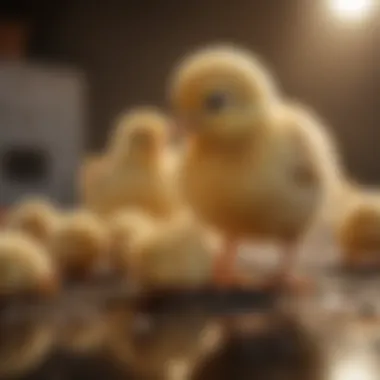
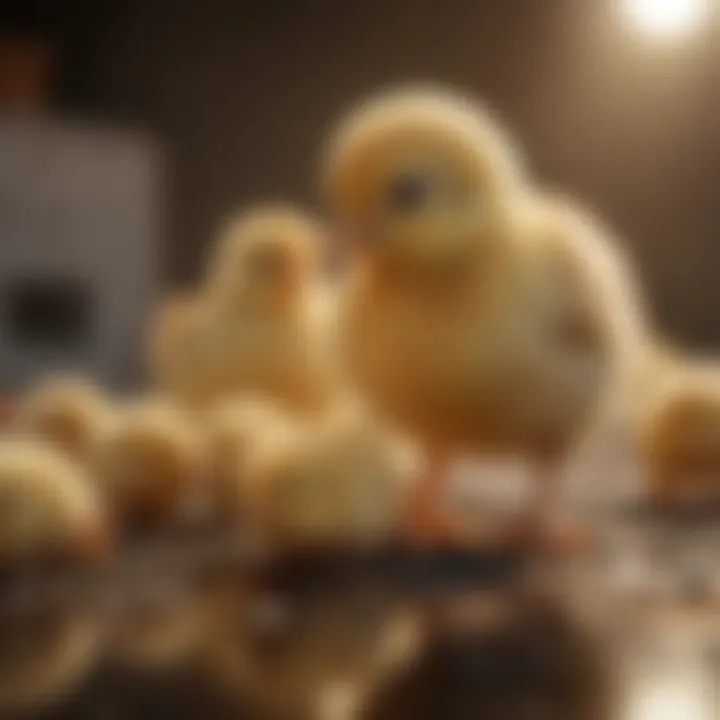
When creating homemade feed, common ingredients include corn, wheat bran, oats, and protein sources like soybean meal or fish meal. Introducing fresh fruits and vegetables, while ensuring they are safe for chicks, can also enhance nutrition. You might think of it like meal prepping that you did back in your kitchen days.
One unique feature of homemade feed is its customization potential. If you notice that your chicks tend to prefer certain flavors or textures, you can tweak the recipe to cater to them. However, ensuring that the homemade mix has balanced nutrition can be tricky—it involves a bit of research and care.
Pros and Cons of Homemade Feed
While there are benefits, it’s essential to weigh these against the disadvantages. Homemade feed can often be fresher and more appetizing, giving your chicks a variety in taste, which promotes better eating behavior. On the downside, it might not always contain all the necessary nutrients in the correct ratios. This inconsistency can lead to nutritional deficiencies, which can cause problems in the long run.
Homemade feed requires diligence, research, and perhaps a bit of trial and error to get right.
In the end, whether you choose commercial starter feed or whip up a homemade mix, the most important thing is good nutritional balance for the health of your flock. Both options have merit, and understanding your chicks' needs can guide you toward the best choice.
Feeding Techniques
Feeding techniques are crucial for the health and growth of newly hatched chicks. Just like nurturing a delicate seedling, understanding how to provide food effectively can lay the groundwork for robust development. This section will cover various feeding approaches essential for optimal nutrition, emphasizing not only the frequency of feedings but also the methods of introducing food to these fledgling creatures.
Feeding Frequency for Chicks
Getting the feeding frequency right is more than just counting the hours between meals; it’s about establishing a rhythm that supports the chicks’ galloping metabolism. Newly hatched chicks usually need small, frequent meals throughout the day—about every 2 to 3 hours is a common guideline. This frequency keeps their energy levels stable as they begin to explore their surroundings.
Chicks have tiny stomachs, so overstuffing them is not a great idea. Instead of a couple of big meals, think of this like offering bite-sized snacks throughout the day. Young chicks rely heavily on constant access to food since they are growing at a speed that’s nothing short of astounding. Feeding them too infrequently may lead to stress and sluggish growth.
Methods of Introducing Food
Understanding how to introduce food forms the backbone of proper chick nutrition. The age-old debate here is whether to funnel them into the feeder or let them munch as they please. Each has its merits, and striking a balance is key.
Using Feeders Safely
When considering the use of feeders, safety isn’t just a buzzword; it’s the golden rule. Feeders must be designed to prevent the chicks from getting stuck or injuring themselves as they dive for the delicious morsels. A good feeder should have smaller holes for the feed, which decreases waste and makes it easier for the little birds to eat.
Not only does a well-constructed feeder promote healthy eating habits, but it also reduces mess—something every poultry keeper appreciates. Moreover, keeping the feeder clean helps to mitigate issues related to mold or spoilage, ensuring that every crumb available is nutritious. Using feeders safely means less stress for both the caretaker and the chicks.
Free-Feeding vs. Measured Feeding
The debate over free-feeding versus measured feeding is not merely academic; it impacts the well-being of the chicks significantly. Free-feeding means the feed is available all day, allowing chicks to nibble whenever they fancy. This method can be advantageous as it aligns well with their natural instincts to forage. Yet, too much food can lead to overeating, which might bring about some unwanted health complications.
On the other hand, measured feeding involves portioning out daily feed into set intervals. This method makes sure no chick gets left scrambling to the bottom of the feed pile while others hog all the goodies. However, it can be a bit tricky to gauge how much a chick actually needs at a given time.
Ultimately, using a combination of both approaches often yields the best results. Take note of individual chick behavior and growth, and adjust feeding methods accordingly. Each method has its unique benefits and drawbacks, so always keep an open mind and adapt as necessary.
Water and Hydration Needs
Water is an essential part of a chick's overall nutrition plan. Newly hatched chicks, though minuscule, have a surprisingly high need for water relative to their size. Proper hydration plays a critical role in their development, digestion, and general well-being. Without sufficient water intake, these little creatures can quickly face serious health issues, including dehydration, poor growth, and even mortality.
The significance of water often gets neglected, but it’s like putting gas in a car – you can’t expect it to run smoothly without it! Chicks should have access to clean, fresh water at all times. Proper hydration not only helps to support their digestion but also fortifies their immune system, making them less susceptible to diseases.
Importance of Water for Chicks
When it comes to hydration, water serves up more than just thirst quenching; it acts as a vehicle for nutrients and plays a vital role in temperature regulation. Chicks regulate their body temperature mostly through water intake, which is crucial in their early days, especially as they transition from the warmth of the incubator to a cooler environment. Without adequate hydration, they risk suffering from various ailments, including stunted growth and lethargy.
Moreover, water impacts digestion significantly. The digestive system of a chick is still maturing, and sufficient water intake helps to break down the feed they consume, allowing for the full absorption of essential nutrients. The right amount of hydration also helps keep their droppings moist, which can prevent issues related to sanitation and health.
Providing Clean Water
Water Sources
Selecting a suitable water source can significantly influence a chick's health. Common sources include clean bowls, waterers designed specifically for poultry, or even small containers that prevent drowning. The crucial thing is to ensure they’re made from safe materials that won't contaminate water. Chicks are indeed curious creatures, and they might peck around with their beaks, so a stable and secure source is key.
A popular choice among poultry keepers is the use of nipple drinkers. These keep the water clean as they prevent spillage and contamination. Plus, they’re easy to install and adjust as the chicks grow. The main advantage is that it minimizes the risk of disease transmission, which can happen with open water sources where droppings might get mixed in.
However, one must be wary of learning curves for the chicks. They may take a while to adapt, requiring some patience from the keeper's end. The unique challenge here is ensuring all chicks get familiar with drinking from these sources, which can vary based on the type employed.
Frequency of Water Change
Changing the water frequently is essential for keeping it clean and safe for chicks. Many poultry experts recommend changing the water at least twice a day, especially in warmer climates where higher temperatures can lead to algae growth and bacteria development.
A clear key characteristic of frequently changed water is its freshness. Fresh water encourages better drinking habits among chicks, directly affecting their hydration and health. Not only does this practice prevent water from becoming stale or dirty, but it also helps to eliminate any odors that can otherwise attract pests.
One unique feature in this discussion is the varying water consumption rates dependent on the chicks’ age and environment. Younger chicks generally drink less than their older counterparts. Therefore, keeping a keen eye on their water containers can help in minimizing waste and maintaining hygiene. It’s a bit of a balancing act but achieving the right rotation will support a healthier flock overall.
Common Mistakes in Feeding Chicks
In the nurturing journey of poultry keeping, feeding newly hatched chicks correctly cannot be overstated. Mistakes in this vital stage can spiral into problems down the line, leading to poor health and stunted growth. It’s crucial to be aware of the traps that prevent your flock from thriving. In this section, we’ll examine two prevalent issues: overfeeding and nutritional imbalances, guiding you to sidestep common pitfalls that inhibit proper development.
Overfeeding Dangers
Overfeeding chicks can seem like an innocent mistake, yet it often leads to grave consequences. These little birds are remarkably quick to consume food, but their little bodies have limits. Providing more food than they realistically need can strain their digestive systems. This can trigger excessive weight gain, leading to obesity. Chicks that are overweight may struggle with mobility, resulting in reduced activity and potential health complications.
Additionally, the hazard of feed waste becomes more pronounced. When you overfill the feeders, not only does it encourage picky eating habits, but it also elevates the risk of spoilage. Chicks might engage in selective eating, favoring their preferred morsels, while neglecting the balanced nutrients required for healthy growth.
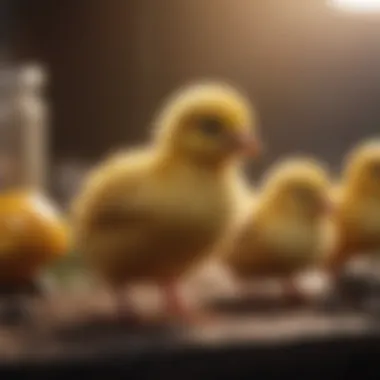
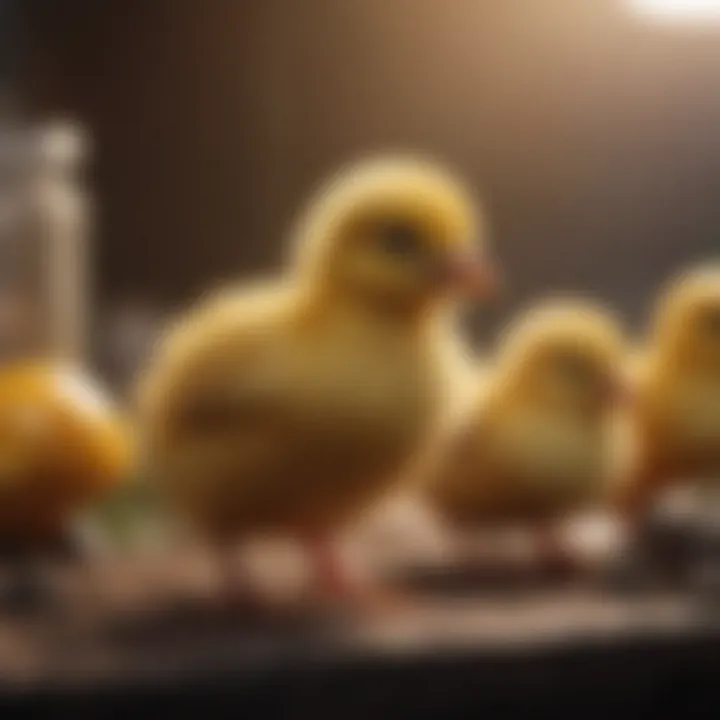
Key points to remember about overfeeding:
- Monitor feeding amounts meticulously,
- Adjust feed according to growth conditions,
- Provide smaller, frequent meals instead of large heaps.
"Overfeeding might seem harmless at first, but it can be a slippery slope to serious health concerns for your chicks."
Nutritional Imbalances
Nutritional imbalances can arise from a poorly considered feeding regimen, manifesting in profound ways that may not be immediately obvious. A lack of essential vitamins, minerals, or proteins can lead to a range of deficiencies that stunt growth and lower immunity. For example, insufficient calcium can result in weak bones, while inadequate protein may hinder muscle development, making chicks more susceptible to disease.
On the flip side, excesses can be just as damaging. Too much of certain nutrients, such as protein or certain vitamins, can cause developmental disorders. This means that simply feeding a variety of foods without a proper understanding of their nutritional content is akin to playing a game of chance.
When you balance their diets, it might also help to use nutrient-rich commercial feeds, which are specifically designed to meet the needs of growing chicks. Homemade diets, while sometimes more economical, can often fall short unless meticulously formulated.
Important reminders for nutritional balance:
- Opt for well-formulated feeds,
- Check ingredient labels for completeness,
- Adjust diets as chicks grow and needs change.
By being diligent in feeding, monitoring, and adapting your approach, you set the stage for a healthy, thriving flock. Taking the time to understand these common mistakes in feeding chicks could very well be the difference between a flock that flourishes or one that struggles.
Monitoring Growth and Health
Keeping an eye on the well-being of newly hatched chicks is paramount. The early days of a chick's life are crucial for their development, and monitoring their growth and health can make or break their future. By observing their progress, poultry keepers can ensure that these young birds are on the right track, catching any issues before they snowball into serious problems. There’s a lot to gain from routinely checking in on their physical condition, and it can also give a keeper peace of mind knowing that all is well.
Signs of Healthy Chick Development
When it comes to recognizing healthy development in chicks, there are several telltale signs that a careful observer can spot. Here are a few indicators that the chicks are thriving:
- Active Behavior: Healthy chicks are typically very active, constantly moving and exploring their surroundings. If they are lethargic or staying in one place too long, it may signal a problem.
- Vigorous Eating and Drinking: A healthy appetite is essential. Chicks should eagerly go to their feed and drink water without hesitation. A lack of interest in food can indicate underlying health issues.
- Body Weight: Consistent weight gain is a strong indication that chicks are developing properly. Monitoring their weight weekly can help keep tabs on their growth. If a chick shows little to no weight gain for more than a couple of days, it might be worth investigating.
- Feather Development: As chicks mature, they begin to grow feathers. The presence of healthy feathers is a good sign of proper nutrition and overall health.
Observing these signs provides the keeper with a clearer picture of the flock's well-being. A proactive approach could prevent any setbacks that hinders growth.
Identifying Nutritional Deficiencies
Despite the best efforts to provide nutritious feed, deficiencies sometimes arise. Identifying these is crucial for ensuring that chicks reach their full potential. Here are some common signs of nutritional deficiencies to watch out for:
- Poor Feather Quality: If feather growth is sparse or appears ragged, it may indicate a lack of essential nutrients. For instance, a deficiency in protein could stunt feather growth.
- Weak Bones and Poor Mobility: Signs such as splayed legs or difficulty in walking can point to deficiencies in calcium or vitamin D. Both are crucial for bone health and overall development.
- Lethargic Behavior: As previously mentioned, active behavior is key. If chicks are more lethargic than usual, it might suggest they are not getting enough vitamins and minerals.
- Abnormal Stool: Monitoring droppings might seem trivial, but unusual colors or consistency can be indicators of diet-related issues. Healthy chicks typically produce droppings that are well-formed and not overly watery.
Being mindful of these signs allows a keeper to take immediate action, adjusting diets or seeking veterinary advice when necessary.
By paying close attention to the growth and health of chicks, keepers can ensure a robust start to their life – it's all about laying the groundwork for strong and healthy poultry.
Transitioning to Adult Feed
As chicks grow and develop, their nutritional needs change significantly. This shift is not merely a matter of changing the food they eat, but rather ensuring they receive the right balance of nutrients to support their growth at different stages. The period of transitioning from chick starter feed to adult feed is crucial for promoting health and vitality in poultry. Getting this transition right can help prevent nutritional deficiencies and foster a smoother development into adulthood.
Understanding Growth Stages
The growth of chickens is typically divided into distinct stages, each with its own dietary requirements. Initially, they start as tiny hatchlings reliant on the yolk sac for nourishment, which provides them with essential nutrients. After a few days, they are ready for starter feed designed specifically for their needs.
- Chick Stage (0-6 weeks)
In this stage, they need a nutrient-rich diet that supports rapid growth. High-protein chick starter feeds (about 20-24% protein) are ideal. - Growing Stage (6-12 weeks)
During this phase, their growth slows, but they still need high levels of protein, albeit at a slightly lower percentage (16-18%). At this stage, they can start to be introduced to mixed feed options, which contain grains along with poultry-specific nutrients. - Maturing Stage (12 weeks and older)
By now, the chicks are nearing maturity. Their diet can shift towards adult feeds, which generally contain lower protein levels suitable for maintenance rather than growth (14-16%). These feeds usually include a balance of vitamins and minerals needed for overall health.
The timing for moving from one stage to the next can depend on factors like breed, growth rate, and individual health. It’s essential to observe the overall condition of your birds and consult your feed supplier for the best recommendations.
Gradual Feed Transition Strategy
Transitioning to adult feed should not be an abrupt change. Instead, it’s a process that requires a thoughtful approach. Here are some strategies to ensure a smooth transition:
- Start Slowly: Mix some adult feed with their current diet to help them adjust. Begin with a small amount, about 10-15% of their total feeding. Gradually increase the proportion of adult feed over a week or two.
- Monitor Reactions: Watch how the chicks respond to the new feed. Healthy, curious behavior should be encouraged, meaning they are open to trying new foods. If certain chicks are hesitant, reduce the adult feed mix until they acclimatize.
- Provide Variety: Incorporating some whole grains or even fruits and vegetables can make the change more palatable. This not only supports their digestion but also enriches their diet with natural flavors.
- Assess Nutritional Needs: As your chicks transition, ensure that the feed still meets the necessary requirements for their growth and health. Check labels for protein content and essential vitamins and minerals.
By understanding the growth stages and implementing a gradual transition strategy, new poultry keepers can ensure that their birds develop healthily and efficiently.
In sum, transitioning to adult feed is an integral part of chick development. By being aware of their growth stages and providing a slow and steady switch to adult nutrition, you set the ground for a thriving flock.
End
In the context of nurturing newly hatched chicks, the conclusion serves as a vital reflection of the essential components that have been discussed throughout this guide. Proper nutrition for chicks is not merely a checklist of feeding routines and food types; it's an elaborate framework built upon understanding the unique requirements of these young birds. The emphasis placed on monitoring growth, recognizing signs of health, and transitioning between food stages all contribute to robust development, illustrating how intertwined these elements are in the overall health of the flock.
It's crucial to note that balancing nutrient intake while avoiding common pitfalls can set the stage for vibrant and thriving adult birds. Inadequate nutrition can lead to longer-term impacts on health and productivity, so making informed food choices is a cornerstone for any poultry keeper. The journey from hatchling to chicken is transformative, and proper nourishment is the fuel they need to navigate this phase with vigor.
Summarizing Key Points
To encapsulate the insights provided:
- Nutrition Needs: Newly hatched chicks require a carefully balanced diet rich in protein, vitamins, and minerals to facilitate growth.
- Feeding Techniques: Understanding proper feeding practices, such as feeding frequency and methods of introducing food, supports healthy eating habits.
- Water Importance: Clean and accessible water is indispensable for hydration and digestion, a focal point that should never be overlooked.
- Observation: Regular monitoring of chicks' growth and health must be prioritized, outfitting keepers with the necessary tools to spot deficiencies early on.
- Transitioning: Gradual adjustments as chicks age ensure that their changing nutritional needs are met without abrupt dietary shifts.
By encapsulating these elements, you set a solid foundation for a thriving poultry environment.
Encouragement for New Poultry Keepers
For those stepping into the realm of poultry keeping, the intricacies of chick nutrition may seem overwhelming at first. However, remember that every expert was once a novice. Embrace the learning journey.
Don't hesitate to reach out to seasoned keepers, or refer to reliable sources like
Wikipedia and
Britannica. Forums such as
Reddit can also be invaluable for sharing experiences and insights.
Keep in mind that consistent care and a willingness to adapt are key traits of a successful poultry keeper. As you gain experience, your competence and confidence will burgeon, leading to a fulfilling journey marked by the joyful sounds of healthy chicks growing into resilient adult birds. Just take it step by step; you're not alone in this adventure, and soon enough, you'll be reaping the rewards of your hard work!







